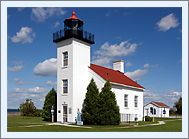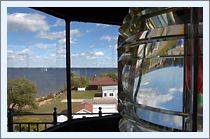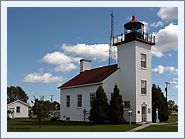 |
 |
 |
| Click thumbnails to view enlarged images | ||
| Sand Point Lighthouse | Seeing The Light |
|
|
|
|
Historical
Information With the completion of the Peninsula Railroad in 1864, which linked Escanaba to the iron mines of Negaunee, and the subsequent construction of ore docks in the harbor, it was clear that Escanaba was finally "on the map." Realizing the need for a navigational aid to guide the growing maritime traffic, the Lighthouse Board again began calling for funding, and Congress responded with a duplicate of the earlier appropriation on July 2, 1864. A site for the light on Sand Point was selected soon thereafter, but the owner of property experienced difficulty in proving clear title to the site, and little could be done until the matter of title was decided beyond preparing plans and cost estimates for constriction.
Construction began early that fall, and over the following months a forty-one foot brick tower and attached 1 ½-story dwelling took shape on Sand Point. Plans for the station were modifications of structures built concurrently at a number of locations around the district, including Ontonagon, Gull Rock and Copper Harbor, among others. The square tower was capped with a prefabricated decagonal cast iron lantern, and outfitted with a fixed white Fourth Order Fresnel lens. Strangely, the structure was constructed in the exact opposite orientation to any other light on the Great Lakes, in that the structure was built with its' tower at the landward end of the dwelling. Since we have been unable to find any mention of this disorientation from the norm in any historical documents, we can only assume that it was either erected in this manner in error, or was erected that way as an experiment.
Evidently the construction of the station was good, as the Ninth District Inspector reported that the condition of the structure was good in all aspects, except that the chimney smoked badly in his 1869 inspection of the station. With increasing development of the downtown area, the number of city lights behind the station increased quickly, and many mariners complained of difficulty in differentiating the fixed white light from the city lights behind it. Taking up their call, Michigan Senator Chandler presented two petitions in the Senate on February 7, 1872 on behalf of shipmasters and vessel owners, praying that a red light be substituted for the fixed white light. The matter was referred to the Commerce Committee, which evidently concurred with the suggestion, since the Sand Point light appears as having a fixed red characteristic in subsequent Great Lakes Light Lists. Evidently, there was little of note occurring a Sand Point over the next decade, since no mention of the station appears in Lighthouse Board documents beyond mentions of minor repairs being made. Then out of the blue on the night of March 4, 1886, a major fire broke out in the dwelling, killing Mary Terry and almost destroying the dwelling. Once the fire was extinguished, it was found that the south lighthouse door showed signs of forced entry, and there was local speculation that a thief had broken into the station, and put a torch to the place when they were discovered my Mrs. Terry. One local newspaper also questioned the performance of the city firefighters, questioning why it took them so long to respond, and basically blaming the complete burning of the dwelling on their slow reaction. A subsequent investigation of the fire by the Delta County coroner found no specific culpability, finding only that only that Mrs. Terry "came to her death from causes and by means unknown." Immediately on hearing of Mary Terry’s death, the Ninth District Inspector Commander Francis A. Cook appointed Lewis A Rose from Wind Point where he had been serving as First Assistant Keeper since entering lighthouse service in 1883.
400 feet of board fencing was installed on the north, south and east sides of the lighthouse site in 1890, and the decision was made to install a fog bell at the station for vessels to use during thick weather. Estimating that a bell and automatic striking apparatus could be installed for a total cost of $1,000, a request for an appropriation was included in the 1890 annual report. Evidently Congress was not immediately convinced of the need for such an enhancement at the station, since the Lighthouse Board reiterated its request in subsequent annual reports for the following four years. Perhaps using the negotiating tactic of "asking for ten when you really want five," the Board upped the ante in 1895, recommending instead an appropriation $5,000 for the establishment of a duplicate steam-powered fog signal system at the station.
The following year, a number of changes were instituted which were geared towards improving the safety of the station keeper. Metal handrails were installed in the tower to make ascending and descending the stairs easier, a free standing brick oil storage building was erected, the wooden sidewalks were upgraded to concrete and the kitchen sink and sewer pipes were replaced.
With the increasing size of vessels entering the harbor, mariners needed to maintain deeper water, and the decision was made to build a new tower on a crib a quarter of a mile offshore from the old light to better mark the limits of deep water. With the establishment of this new Escanaba Light in 1838, the old Sand Point Light was extinguished and rendered obsolete.
With the construction of new purpose-designed quarters in 1985, the Coast Guard determined that the station was no longer needed. Learning that the old structure was to be abandoned, the Delta County Historical Association obtained a 30-year lease on the property in 1986, and set about formulating a plan to undertake the daunting task of returning Sand Point to its original glory.
The Delta County Historical Society re-furnished all the rooms in the
lighthouse to appear as they would have at the turn of the twentieth
century, and proudly opened the lighthouse to the public in July of
1990. Directions: In Escanaba at the junction of US-2[US-41 and M-35, go
east on Ludington St., under the arch crossing the road, approximately
1.7 miles to the lighthouse. The Delta County Historical Museum and
Archives are both located immediately behind the lighthouse in former
Coast Guard buildings. |